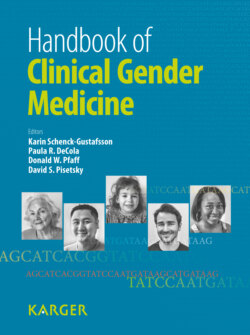Читать книгу Handbook of Clinical Gender Medicine - Группа авторов - Страница 121
Abstract
ОглавлениеThe translation of observed sex differences in depression and its treatment into clinical practice is in an immature stage of development. Indeed, the literature to date provides no compelling clear-cut guidelines for the selection or avoidance of any psychotropic medication on the basis of sex alone. The current lack of translation, however, is counterbalanced by a voluminous body of literature suggesting that sex, as one of several critical contextual factors, impacts the regulation and dysregulation of affect.
Copyright © 2012 S. Karger AG, Basel
Sex differences that may impact the presentation and treatment of depression will often remain undisclosed unless clinicians remain vigilant to their possible influence. For instance, victims of sexual abuse, who are most often women, frequently exhibit dysregulation of the hypothalamic-pituitary-adrenal axis and experience depressions that typically are responsive to psychotherapy. However, without specific inquiries, this contextual information will often go undisclosed. Similarly, drug abuse, which is more prevalent in men, can greatly complicate the presentation and treatment of depression. Finally, there are culture-bound sex differences in presentation that often reflect the relative reluctance in men to endorse symptoms of sadness. Consequently, the likelihood of overlooking clinically relevant depressive episodes in men will be substantial unless the physician makes a concerted effort to elicit evidence of either a past or a present depressive disorder. Failure to detect comorbid depression is particularly problematic, as it results in increased treatment costs for the primary illness, greater pathological progression of illness, and an increased likelihood of death.
The goal of individualized medicine is the prediction of therapeutic interventions that will have the greatest efficacy and the least adverse effects. This goal will be met only when our clinical databases are sufficiently populated and integrated to permit identification of relevant contextual predictors (be they genomic, historical, psychological, or physiological). Currently available genetic, psychobiological, brain imaging, and pharmacological evidence for the existence of meaningful sex differences makes unimaginable a future in which sex will not be viewed as one of the most powerful predictors of vulnerability to and expression of depression and other affective disorders.
